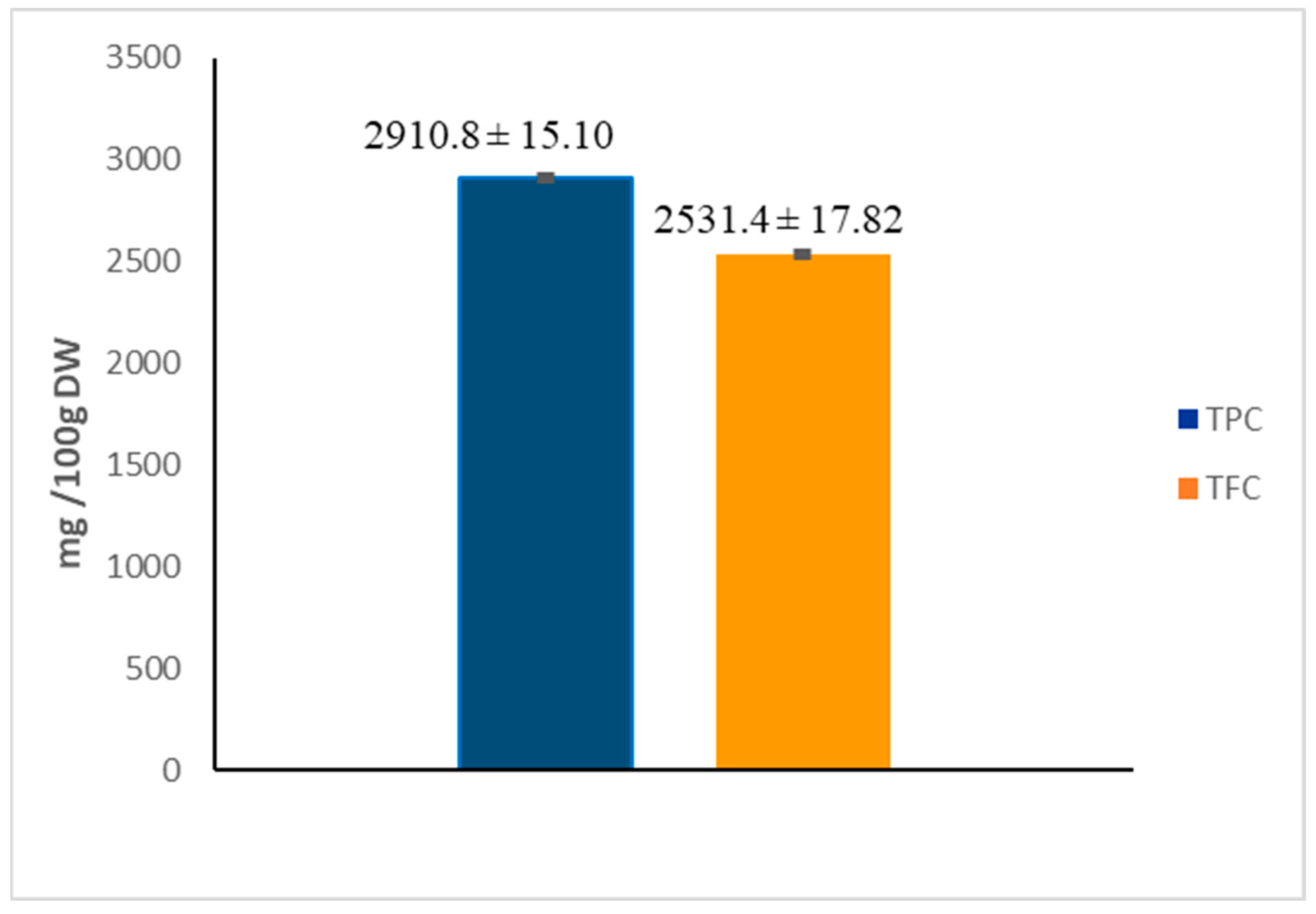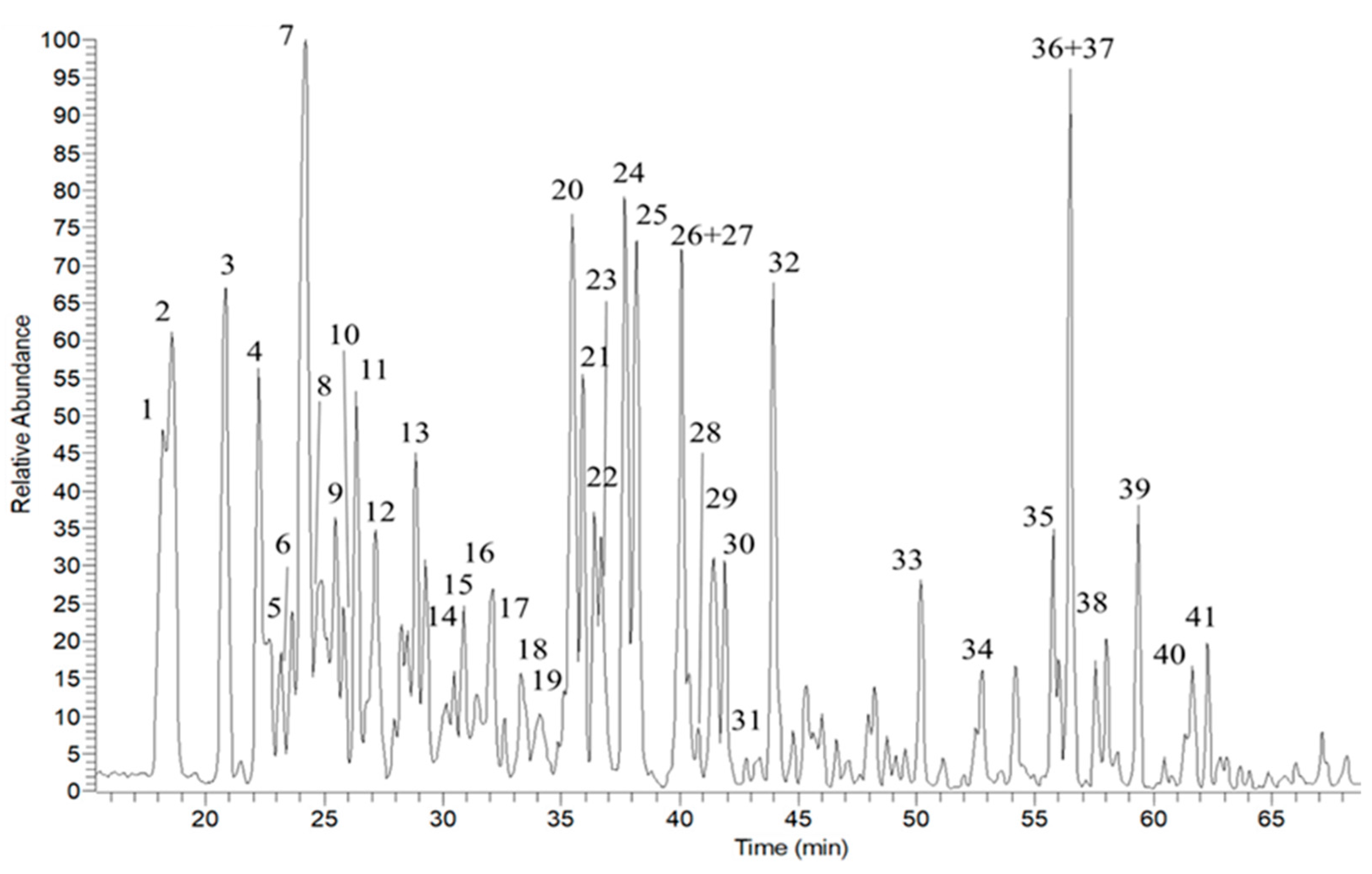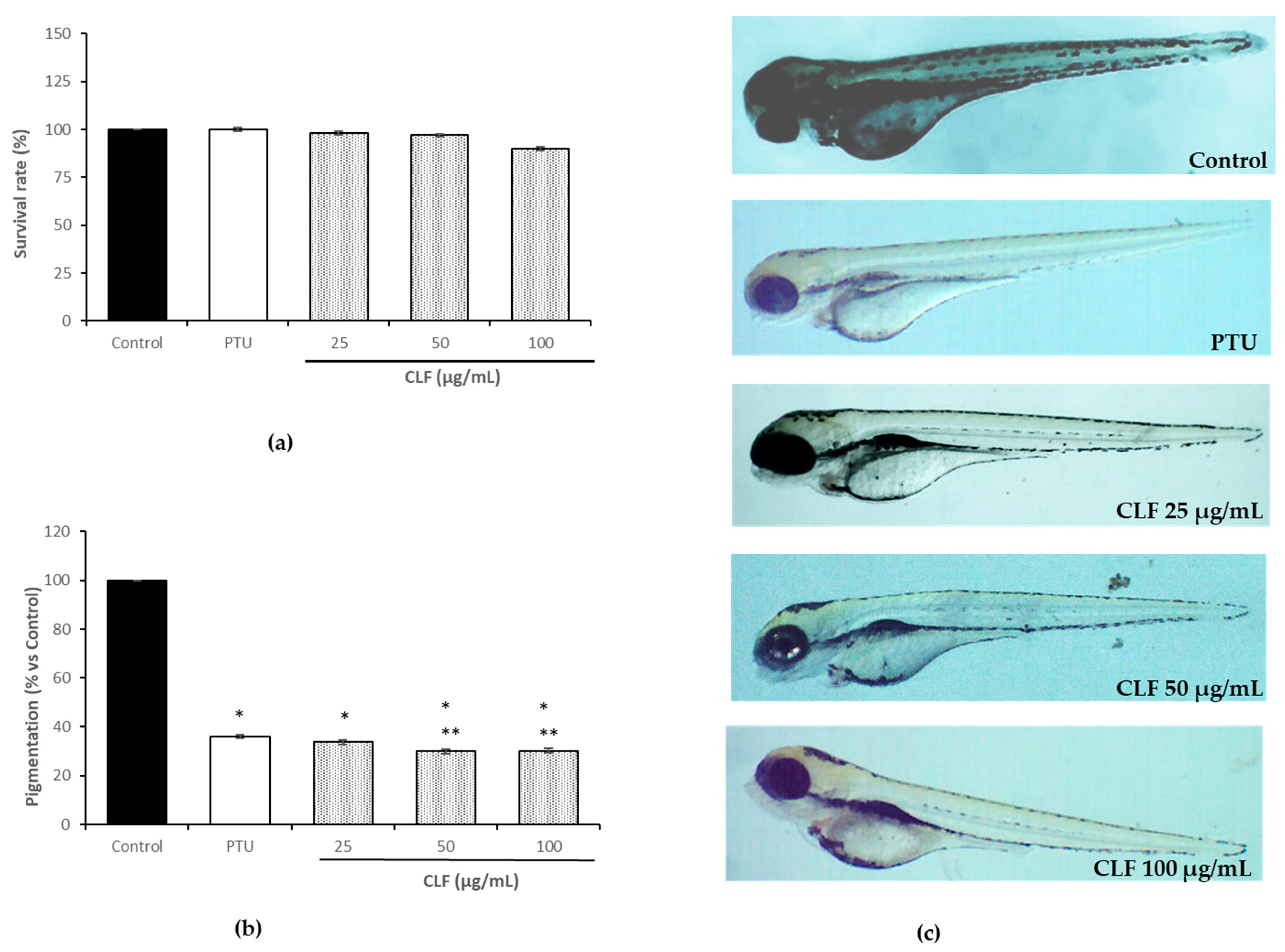Chemical Profile and Health-Promoting Activities of Crataegus laciniata (Rosaceae) Flowers
Abstract
:1. Introduction
2. Results
2.1. Total Phenolic (TPC) and Flavonoid (TFC) Content
2.2. Phytochemical Characterization
2.3. Antioxidant Activity
2.4. α-Amylase and α-Glucosidase Inhibitory Activity
2.5. Inhibitory Effects on Tyrosinase Enzyme
2.6. Inhibitory Effects on Melanogenesis in Zebrafish Embryos
3. Discussion
4. Materials and Methods
4.1. Sample Preparation and Extraction
4.2. Chemicals and Reagents
4.3. Determination of Total Phenolic Content (TPC)
4.4. Determination of Total Flavonoid Content (TFC)
4.5. LC-MS/MS Qualitative Analysis
4.6. Determination of Antioxidant Activity
4.7. α-Amylase Inhibitory Assay
4.8. α-Glucosidase Inhibitory Assay
4.9. Tyrosinase Enzyme Inhibitory Assay
4.10. Zebrafsh Embryo Maintenance and Treatment
4.11. Statistical Analysis
5. Conclusions
Author Contributions
Funding
Data Availability Statement
Conflicts of Interest
References
- Venskutonis, P.R. Phytochemical composition and bioactivities of hawthorn (Crataegus spp.): Review of recent research advances. J. Food Bioact. 2018, 4, 69–87. [Google Scholar] [CrossRef]
- Nazhand, A.; Lucarini, M.; Durazzo, A.; Zaccardelli, M.; Cristarella, S.; Souto, S.B.; Silva, A.M.; Severino, P.; Souto, E.B.; Santini, A. Hawthorn (Crataegus spp.): An Updated Overview on Its Beneficial Properties. Forests 2020, 11, 564. [Google Scholar] [CrossRef]
- Issaadi, O.; Fibiani, M.; Picchi, V.; Lo Scalzo, R.; Madani, K. Phenolic composition and antioxidant capacity of hawthorn (Crataegus oxyacantha L.) flowers and fruits grown in Algeria. J. Complement. Integr. Med. 2020, 17, 20180125. [Google Scholar] [CrossRef] [PubMed]
- Calvo, J.; Ufimov, R.; Aedo, C. Proposal to conserve the name Crataegus laciniata (Rosaceae) with a conserved type. Taxon 2015, 64, 175–176. [Google Scholar] [CrossRef]
- Sumner, L.W.; Amberg, A.; Barrett, D.; Beale, M.; Beger, R.; Daykin, C.; Fan, T.; Fiehn, O.; Goodacre, R.; Griffin, J.; et al. Proposed minimum reporting standards for chemical analysis. Metabolomics 2007, 3, 211–221. [Google Scholar] [CrossRef]
- Edwards, J.E.; Brown, P.N.; Talent, N.; Dickinson, T.A.; Shipley, P.R. A review of the chemistry of the genus Crataegus. Phytochemistry 2012, 79, 5–26. [Google Scholar] [CrossRef]
- Bardakci, H.; Celep, E.; Gözet, T.; Kan, Y.; Kırmızıbekmez, H. Phytochemical characterization and antioxidant activities of the fruit extracts of several Crataegus taxa. S. Afr. J. Bot. 2019, 124, 5–13. [Google Scholar] [CrossRef]
- Tsimogiannis, D.; Samiotaki, M.; Panayotou, G.; Oreopoulou, V. Characterization of flavonoid subgroups and hydroxy substitution by HPLC-MS/MS. Molecules 2007, 12, 593–606. [Google Scholar] [CrossRef]
- Belkhir, M.; Rebai, O.; Dhaouadi, K.; Congiu, F.; Tuberoso, C.I.G.; Amri, M.; Fattouch, S. Comparative analysis of Tunisian wild Crataegus azarolus (yellow azarole) and Crataegus monogyna (red azarole) leaf, fruit, and traditionally derived syrup: Phenolic profiles and antioxidant and antimicrobial activities of the aqueous-acetone extracts. J. Agric. Food Chem. 2013, 61, 9594–9601. [Google Scholar] [CrossRef]
- Bahri-Sahloul, R.; Ammar, S.; Fredj, R.B.; Saguem, S.; Grec, S.; Trotin, F.; Skhiri, F.H. Polyphenol contents and antioxidant activities of extracts from flowers of two Crataegus azarolus L. varieties. Pak. J. Biol. Sci. 2009, 12, 660–668. [Google Scholar] [CrossRef]
- Lordan, S.; Smyth, T.J.; Soler-Vila, A.; Stanton, C.; Ross, R.P. The α-amylase and α-glucosidase inhibitory effects of Irish seaweed extracts. Food Chem. 2013, 141, 2170–2176. [Google Scholar] [CrossRef] [PubMed]
- Shen, H.; Wang, J.; Ao, J.; Hou, Y.; Xi, M.; Cai, Y.; Li, M.; Luo, A. Structure-activity relationships and the underlying mechanism of α-amylase inhibition by hyperoside and quercetin: Multi-spectroscopy and molecular docking analyses. Spectrochim. Acta A Mol. Biomol. Spectrosc. 2023, 285, 121797. [Google Scholar] [CrossRef] [PubMed]
- Ni, M.; Hu, X.; Gong, D.; Zhang, G. Inhibitory mechanism of vitexin on α-glucosidase and its synergy with acarbose. Food Hydrocoll. 2020, 105, 105824. [Google Scholar] [CrossRef]
- Thawabteh, A.M.; Jibreen, A.; Karaman, D.; Thawabteh, A.; Karaman, R. Skin Pigmentation Types, Causes and Treatment-A Review. Molecules 2023, 28, 4839. [Google Scholar] [CrossRef] [PubMed]
- Cho, K.; Ryu, C.S.; Jeong, S.; Kim, Y. Potential adverse effect of tyrosinase inhibitors on teleosts: A review. Comp. Biochem. Physiol. C Toxicol. Pharmacol. 2020, 228, 108655. [Google Scholar] [CrossRef] [PubMed]
- Mustapha, N.; Bze’ouich, I.M.; Ghedira, K.; Hennebelle, T.; Chekir-Ghedira, L. Compounds isolated from the aerial part of Crataegus azarolus inhibit growth of B16F10 melanoma cells and exert a potent inhibition of the melanin synthesis. Biomed. Pharmacother. 2015, 69, 139–144. [Google Scholar] [CrossRef]
- Huang, X.-X.; Liu, Q.-B.; Wu, J.; Yu, L.-H.; Cong, Q.; Zhang, Y.; Lou, L.-L.; Li, L.-Z.; Song, S.-J. Antioxidant and tyrosinase inhibitory effects of neolignan glycosides from Crataegus pinnatifida seeds. Planta Med. 2014, 80, 1732–1738. [Google Scholar] [CrossRef]
- Ren, G.; Xue, P.; Sun, X.; Zhao, G. Determination of the volatile and polyphenol constituents and the antimicrobial, antioxidant, and tyrosinase inhibitory activities of the bioactive compounds from the by-product of Rosa rugosa Thunb. var. plena Regal tea. BMC Complement. Altern. Med. 2018, 18, 307–315. [Google Scholar] [CrossRef]
- Orhan, I.E.; Senol, F.S.; Erdem, S.A.; Tatli, I.I.; Kartal, M.; Alp, S. Tyrosinase and Cholinesterase Inhibitory Potential and Flavonoid Characterization of Viola odorata L. (Sweet Violet). Phytother. Res. 2015, 29, 1304–1310. [Google Scholar] [CrossRef]
- Agalou, A.; Thrapsianiotis, M.; Angelis, A.; Papakyriakou, A.; Skaltsounis, A.L.; Aligiannis, N.; Beis, D. Identification of Novel Melanin Synthesis Inhibitors from Crataegus pycnoloba Using an in vivo Zebrafish Phenotypic Assay. Front. Pharmacol. 2018, 9, 265. [Google Scholar] [CrossRef]
- Choi, T.Y.; Kim, J.H.; Ko, D.H.; Kim, C.H.; Hwang, J.S.; Ahn, S.; Kim, S.Y.; Kim, C.D.; Lee, J.H.; Yoon, T.J. Zebrafish as a new model for phenotype-based screening of melanogenic regulatory compounds. Pigment. Cell Res. 2007, 20, 120–127. [Google Scholar] [CrossRef] [PubMed]
- Singleton, V.L.; Orthofer, R.; Lamuela-Raventos, R.M. Analysis of Total Phenols and Other Oxidation Substrates and Antioxidants by Means of Folin-Ciocalteu Reagent. Methods Enzymol. 1999, 299, 152–178. [Google Scholar] [CrossRef]
- Xiong, L.; Yang, J.; Jiang, Y.; Lu, B.; Hu, Y.; Zhou, F.; Mao, S.; Shen, C. Phenolic compounds and antioxidant capacities of 10 common edible flowers from China. J. Food Sci. 2014, 79, C517–C525. [Google Scholar] [CrossRef] [PubMed]
- Pizza, C.; Zhou, L.; De Tommasi, N. Plant Metabolites. Triterpenoid Saponins from Calendula arvensis. J. Nat. Prod. 1987, 50, 927–931. [Google Scholar] [CrossRef]
- De Leo, M.; Iannuzzi, A.; Germanò, M.P.; Camangi, F.; D’Angelo, V.; Diretto, G.; Sevi, F.; De Tommasi, N.; Braca, A. Comparative chemical analysis of six ancient italian sweet cherry (Prunus avium L.) varieties showing antiangiogenic activity. Food Chem. 2021, 360, 129999. [Google Scholar] [CrossRef]
- Wang, S.S.; Wang, D.M.; Pu, W.J.; Li, D.W. Phytochemical profiles, antioxidant and antimicrobial activities of three Potentilla species. BMC Complement. Altern. Med. 2013, 13, 321. [Google Scholar] [CrossRef]
- Uysal, S.; Zengin, G.; Locatelli, M.; Bahadori, M.B.; Mocan, A.; Bellagamba, G.; De Luca, E.; Mollica, A.; Aktumsek, A. Cytotoxic and enzyme inhibitory potential of two Potentilla species (P. speciosa L. and P. reptans Willd.) and their chemical composition. Front. Pharmacol. 2017, 8, 290. [Google Scholar] [CrossRef]
- Hawash, M.; Jaradat, N.; Elaraj, J.; Hamdan, A.; Lebdeh, S.A.; Halawa, T. Evaluation of the hypoglycemic effect of seven wild folkloric edible plants from Palestine. J. Complement. Integr. Med. 2020, 17, 20190032. [Google Scholar] [CrossRef]
- Milella, L.; Milazzo, S.; De Leo, M.; Vera Saltos, M.B.; Faraone, I.; Tuccinardi, T.; Lapillo, M.; De Tommasi, N.; Braca, A. α-Glucosidase and α-Amylase Inhibitors from Arcytophyllum thymifolium. J. Nat. Prod. 2016, 79, 2104–2112. [Google Scholar] [CrossRef]
- Mirabile, S.; Ielo, L.; Lombardo, L.; Ricci, F.; Gitto, R.; Germanò, M.P.; Pace, V.; De Luca, L. Leveraging the 3-Chloro-4-fluorophenyl Motif to Identify Inhibitors of Tyrosinase from Agaricus bisporus. Int. J. Mol. Sci. 2023, 24, 7944. [Google Scholar] [CrossRef]
- Westerfield, M. The Zebrafish Book. A Guide for the Laboratory Use of Zebrafish (Danio Rerio), 4th ed.; University of Oregon Press: Eugene, OR, USA, 2000. [Google Scholar]
- Smeriglio, A.; D’Angelo, V.; Denaro, M.; Trombetta, D.; Raimondo, F.M.; Germanò, M.P. Polyphenol Characterization, Antioxidant and Skin Whitening Properties of Alnus cordata Stem Bark. Chem. Biodivers. 2019, 16, e1900314. [Google Scholar] [CrossRef] [PubMed]



| Peaks | tr (min) | [M+H]+ | [M-H]− | Fragmentation a | Compound | Formula | Error (ppm) | MSI Level a |
|---|---|---|---|---|---|---|---|---|
| 1 | 18.16 | 517.1550 | 355 | Caffeoylquinic acid-O-hexoside | C22H28O14 | −0.34 | 2 | |
| 2 | 18.52 | 517.1550 | 355 | Caffeoylquinic acid-O-hexoside isomer | C22H28O14 | −0.34 | 2 | |
| 3 | 20.77 | 449.1057 b | 287 | Cyanidin-O-hexoside | C21H21O11 | −4.67 | 1 | |
| 4 | 22.50 | 337.0928 | 191;161 | Coumaraylquinic acid | C16H18O8 | 2.98 | 2 | |
| 5 | 22.94 | 325.0945 | 161 | Coumaric acid O-hexoside | C15H18O8 | 8.32 | 2 | |
| 6 | 23.22 | 515.1176 | 323 | Dicaffeoylquinic acid | C25H24O12 | 1.55 | 2 | |
| 7 | 24.11 | 353.0851 | 161 | Caffeoylquinic acid | C16H18O9 | −4.55 | 2 | |
| 8 | 25.33 | 515.138 | 355;161;191 | Caffeoylquinc acid O-hexoside | C22H28O14 | −2.97 | 2 | |
| 9 | 25.43 | 387.2004 | 369;207 | Roseoside | C19H30O8 | −2.44 | 2 | |
| 10 | 26.29 | 577.1372 | 425;289 | Procyanidin dimer | C30H26O12 | 5.54 | 2 | |
| 11 | 26.91 | 577.1372 | 425;290 | Procyanidin dimer isomer | C30H26O12 | 5.54 | 2 | |
| 12 | 27.14 | 611.1580 | 433 | Rutin | C27H30O16 | −4.35 | 1 | |
| 13 | 28.44 | 291.0863 | 273;165;151;123 | Catechin | C15H14O6 | −0.05 | 2 | |
| 14 | 31.06 | 369.1180 | 145;117 | Feruloylquinic acid | C17H20O9 | −0.03 | 2 | |
| 15 | 31.63 | 865.1974 | 695;577;407;287 | Procyanidin trimer | C45H38O18 | 0.00 | 2 | |
| 16 | 32.23 | 627.1565 b | 465;303 | Delphinidin-O-dihexoside | C27H31O17 | 1.59 | 2 | |
| 17 | 32.52 | 449.1078 | 431,416,383 | Luteolin-C-hexoside | C21H20O11 | −0.08 | 2 | |
| 18 | 32.7 | 627.1565 b | 465;303 | Delphinidin-O-dihexoside isomer | C27H31O17 | 1.59 | 2 | |
| 19 | 33.33 | 449.1078 | 431,416,383 | Luteolin-C-hexoside isomer | C21H20O11 | −0.08 | 2 | |
| 20 | 35.4 | 565.1552 | 433;415 | Apigenin-C-hexoside-O-pentoside | C26H28O14 | 0.03 | 2 | |
| 21 | 35.8 | 433.1116 | 415 | Vitexin | C21H20O10 | −3.05 | 1 | |
| 22 | 36.33 | 611.1577 | 465;303 | Quercetin-O-hexoside-rhamnoside | C27H30O16 | −4.84 | 2 | |
| 23 | 36.57 | 611.1577 | 465;303 | Quercetin-O-hexoside-rhamnoside isomer | C27H30O16 | −4.84 | 2 | |
| 24 | 37.57 | 465.1010 | 303 | Hyperoside | C21H20O12 | −3.77 | 1 | |
| 25 | 38.09 | 465.1000 | 301 | Delphinidin-O-hexoside | C21H21O12 | −5.80 | 2 | |
| 26 | 40.03 | 479.1163 | 317 | Methoxyquercetin-O-hexoside | C22H22O12 | −4.38 | 2 | |
| 27 | 40.26 | 449.1078 | 287 | Luteolin-O-hexoside | C21H20O11 | −0.08 | 2 | |
| 28 | 40.33 | 625.1732 | 479;317 | Methoxyquercetin-O-hexoside-rhamnoside | C28H35O16 | −4.95 | 2 | |
| 29 | 41.44 | 449.1057 | 287 | Luteolin-O-hexoside | C21H20O11 | −4.76 | 2 | |
| 30 | 41.46 | 449.1078 | 287 | Luteolin-O-hexoside | C21H20O11 | −0.08 | 2 | |
| 31 | 43.4 | 507.2233 | 463;445;343;301 | Acetylquercetin-C-hexoside | C23H22O13 | −0.08 | 2 | |
| 32 | 45.37 | 535.1069 | 287 | Luteolin-O-malonylhexoside | C24H22O14 | −2.42 | 2 | |
| 33 | 50.12 | 507.2233 | 463;445 | Acetylquercetin-C-hexoside isomer | C23H22O13 | −0.08 | 2 | |
| 34 | 54.16 | 329.2310 | 311;313;293;275 | Trihydroxyoctadecenoic acid | C18H34O5 | −3.64 | 2 | |
| 35 | 55.7 | 331.2465 | 313;295;277 | Trihydroxyoctadecanoic acid | C18H36O5 | −4.22 | 2 | |
| 36 | 56.04 | 293.2104 | 275 | Hydroxyoctadecatrienoic acid | C18H30O3 | −2.38 | 2 | |
| 37 | 56.43 | 311.2212 | 293;275 | Dihydroxyoctadecatrenoic acid | C18H32O4 | −1.28 | 2 | |
| 38 | 57.5 | 333.2617 | 315;297;279 | Trihydroxyoctadecanoic acid isomer | C18H36O5 | −5.40 | 2 | |
| 39 | 59.31 | 289.2367 | 271;253;235 | Dihydroxyphenylnonanoic acid | C16H32O4 | −2.07 | 2 | |
| 40 | 61.31 | 309.2074 | 291;273 | Dihydroxyoctadecatrenoic acid isomer | C18H28O4 | 4.54 | 2 | |
| 41 | 62.28 | 309.2074 | 291;274 | Dihydroxyoctadecatrenoic acid isomer II | C18H28O4 | 4.54 | 2 |
| DPPH (IC50 µg/mL) | TEAC (IC50 µg/mL) | FRAP (TE/g Extract) | |
|---|---|---|---|
| CLF | 165.25 ± 0.15 | 20.13 ± 0.09 | 75.61 ± 0.025 |
| Ascorbic acid | 16.95 ± 1.20 | ---- | ---- |
| Trolox | ---- | 13.08 ± 0.02 | ---- |
| α-Amylase (IC50 µg/mL) | α-Glucosidase (IC50 µg/mL) | |
|---|---|---|
| CLF | 517.41 ± 36.86 | 4.56 ± 0.13 |
| Acarbose | 29.07 ± 1.9 | 436.47 ± 58.82 |
| Monophenolase (IC50 µg/mL) | Diphenolase (IC50 µg/mL) | |
|---|---|---|
| CLF | 67.47 ± 3.86 | 103.61 ± 5.46 |
| Kojic acid | 9.18 ± 1.24 | 2.52 ± 0.81 |
Disclaimer/Publisher’s Note: The statements, opinions and data contained in all publications are solely those of the individual author(s) and contributor(s) and not of MDPI and/or the editor(s). MDPI and/or the editor(s) disclaim responsibility for any injury to people or property resulting from any ideas, methods, instructions or products referred to in the content. |
© 2023 by the authors. Licensee MDPI, Basel, Switzerland. This article is an open access article distributed under the terms and conditions of the Creative Commons Attribution (CC BY) license (https://creativecommons.org/licenses/by/4.0/).
Share and Cite
Mirabile, S.; D’Angelo, V.; Germanò, M.P.; Pouramin Arabi, S.; Parisi, V.; Raimondo, F.M.; Rosa, E. Chemical Profile and Health-Promoting Activities of Crataegus laciniata (Rosaceae) Flowers. Plants 2024, 13, 34. https://doi.org/10.3390/plants13010034
Mirabile S, D’Angelo V, Germanò MP, Pouramin Arabi S, Parisi V, Raimondo FM, Rosa E. Chemical Profile and Health-Promoting Activities of Crataegus laciniata (Rosaceae) Flowers. Plants. 2024; 13(1):34. https://doi.org/10.3390/plants13010034
Chicago/Turabian StyleMirabile, Salvatore, Valeria D’Angelo, Maria Paola Germanò, Shiva Pouramin Arabi, Valentina Parisi, Francesco Maria Raimondo, and Emanuele Rosa. 2024. "Chemical Profile and Health-Promoting Activities of Crataegus laciniata (Rosaceae) Flowers" Plants 13, no. 1: 34. https://doi.org/10.3390/plants13010034





